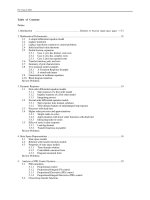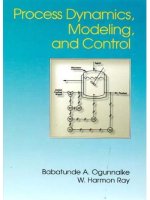Carnell MATLAB applications in chemical engineering
Bạn đang xem bản rút gọn của tài liệu. Xem và tải ngay bản đầy đủ của tài liệu tại đây (514.33 KB, 13 trang )
MATLAB® Applications in Chemical
Engineering
James A. Carnell
North Carolina State University
MATLAB is a powerful code-based mathematical and engineering calculation
program. It performs all calculations using matrices and vectors in a logical programming
environment. This guide is a brief introduction to MATLAB in chemical engineering, and
in no way attempts to be a comprehensive MATLAB learning resource. This guide is a
starting point for the new MATLAB user, and as such no prior MATLAB experience is
necessary. Further help can be found in the MATLAB help files or at Mathworks website
at
www.mathworks.com and in the help section at
/>
MATLAB Applications in Chemical Engineering
James A. Carnell, August 2003
Table of Contents
Section I: How MATLAB Works
» Basic MATLAB: The Language
» Mfiles (Function files)
» Dealing with Functions
The ‘plot’ function
The ‘fzero’ function
Solving linear equations in MATLAB
The ‘fsolve’ function
Section II: Numerical and Symbolic Integration
» Numerical Integration; Quadrature
The Simpson’s Rule and Lobotto Quadrature
» Symbolic Integration and Differentiation
Section III: Numerically Solving Differential Equations and Systems of Differential
Equations
» First order ode’s
» Higher order ode’s
Appendix
» Glossary of Commands, Parts I, II and II
» Line Markers
MATLAB Applications in Chemical Engineering
James A. Carnell, August 2003
Section I: How MATLAB works
Most MATLAB commands can be run from the command window (shown below,
on the right hand side of the interface). MATLAB commands can also be entered into a
text file labeled with the ‘.m’ extension. These files are known as ‘m-files’. These
commands can be broken down into scripts and programming. Scripts can be thought of
as commands that instruct MATLAB to execute a particular function or pre-made
program, and programming can be thought of as the raw code required to construct
functions and programs within MATLAB. Generally, all programming must be contained
within a file used by MATLAB (called an m-file), but script can be entered either in an
m-file or directly into the command window. An image of the MATLAB interface is
shown below.
MATLAB contains many ready-made programs or functions that are conveniently
arranged into different toolboxes. When using MATLAB, these toolboxes and their
functions can be called upon and executed in any MATLAB script. In the above image,
the toolbox selection or launch pad is shown (at the left hand side of the interface).
Basic MATLAB: The language
MATLAB uses a language that is somewhat similar to that of Maple
1
. The scripts
or calling functions have a particular name and argument that must be entered into the
function execution call. For example, to plot the sine function in MATLAB between 0
and 6 using the fplot command, the following code can be entered directly into the
command window, or into an m-file:
1
Maple is a registered trademark of Waterloo Maple, Inc.
MATLAB Applications in Chemical Engineering
James A. Carnell, August 2003
(One can define the function sin(x) in an m-file and replace the fplot command to be
fplot(‘filename’,[0,6]))
Before going much further, an understanding of the structure of a MATLAB
simulation or execution must be developed.
M-files
M-files contain programming, scripts, equations or data that are called upon
during an execution. If the m-file is a function definition, then the most important part of
this type of m-file is the first line. The first line must contain the function definition so
that MATLAB can find those m-files that are called upon. These types of m-files are
called function m-files or function files. The code used to define the function file is as
follows:
‘file_name’ is simply the name of the m-file (the filename must be the same in the
definition and the file-name), z is the dependant variable, and x and y are the independent
variables. (Of course, one can have less or more independent variables depending upon
the complexity of the problem and the equations involved.) The next few lines of script in
the m-file can define the function or functions and label any required variables. The
following is an example of an m-file used to plot the natural logarithm
2
function.
To produce a plot of this function, the following code is entered into the command
window:
This yields a plot of ln(x) between x= 1 and x= 5.
2
MATLAB uses ‘log’ as the natural logarithm function, and ‘log10’ as logarithm base ten.
MATLAB Applications in Chemical Engineering
James A. Carnell, August 2003
Using the ‘insert’ menu one can add a title, x and y axis titles, and if necessary a legend.
One can also use commands nested within the fplot command to title the chart, add axis
titles, or decide upon curve characteristics such as line color or marker.
Dealing with functions
Standard functions such as the sine, cosine, logarithmic, exponential, and user-
defined functions within MATLAB will now be covered. fplot has already been
introduced; now plot, fzero and fsolve will be introduced
The ‘plot’ function
The plot function produces a 2-D plot of a y-vector versus either its real index or a
specified x-vector. The plot function can be used for data, standard functions, or user-
defined functions. Let’s look at a simple example of using plot to model data.
Example 1.1
The following reaction data has been obtained from a simple decay reaction:
A Æ B
Use MATLAB to plot the concentration of component A in mol/L against the reaction
time, t, in minutes. Title the plot, label the axes, and obtain elementary statistics for the
data.
MATLAB Applications in Chemical Engineering
James A. Carnell, August 2003
Solution
First, the data must be entered into MATLAB as two vectors. The vectors x and y
are defined in the command window, followed by the command to plot the data. The
following graph is displayed:
Time
(Minutes)
Concentration
(Moles/Liter)
0 100
1 80
3 65
6 55
9 49
12 45
15 42
18 41
21 38
MATLAB Applications in Chemical Engineering
James A. Carnell, August 2003
The ‘x’ row matrix (or vector*) has its display output suppressed using the ‘;’ at the end
of the line.
Syntax can be used to specify the title and labels, but an easier GUI (Graphical
User Interface) based approach is to simply edit the figure.
Select the ‘Edit Plot’ command found in the ‘Tools’ menu, or click the
north-west facing arrow icon on the figure.
Double click on the white-space in the graph. This enables the property
editor. Now the title and axes can be inserted under the ‘labels’ command.
Now click directly on the line, and the line property editor will come up.
Now the lines color, pattern, or the markers can be edited. The final curve
is presented below:
*A single row matrix or column matrix can represent vectors within MATLAB.
MATLAB Applications in Chemical Engineering
James A. Carnell, August 2003
Solution curve to example 1.1
NOTE: These figures can be exported in .bmp or .jpg format so they can be made part of a document. Find
these under the ‘FileÆExport’ menu.
To display simple statistics of the data, follow the path, ‘ToolsÆData Statistics’ and the
minimum, maximum, mean, median, standard deviation, and range of x and y will be
displayed. Within this box, each statistic can be added to the curve as a data point/line.
To plot functions using plot, an m-file can be created defining the function, or the
definition can be specified in the command window. This is done in a similar fashion as
seen in ‘fplot’. The following code entered into the command window yields a plot of the
exponential function between 0 and 10, at intervals of 1.
MATLAB Applications in Chemical Engineering
James A. Carnell, August 2003
There are many other 2-D plotting functions in Matlab, but fplot, plot and ezplot are the
most useful. ‘ezplot’ is another way to quickly plot functions between specified or non-
specified (-2ʌ<x<2ʌ) intervals. The syntax key for ezplot is shown below.
This can be used to plot f(x) or f(x(t),y(t)).
The ‘fzero’ function
The fzero function is a convenient function used to find local zeros of a one
variable function. The general syntax that can be used for fzero (entered into the
command window) is
x=fzero(‘function’,initial guess)
Matlab will then return the solution or a NaN result. An NaN result is ‘not a number’ and
represents a ‘no solution’ for the function. Below are a few examples relating to fzero.
Example 1.2
Find the zero of the function y(x) = x
2
-1 using an m-file and fzero.
Solution
Create the m-file, ‘myfunction.m’
function y = myfunction(x)
y = x^2-1
In the command window, use fzero to find the zero of the function ‘myfunction’
x = fzero(‘myfunction’,3)
Matlab returns a few iterations and then produces the result ‘x = 1’
MATLAB Applications in Chemical Engineering
James A. Carnell, August 2003
Example 1.3
Find the zero of the function y(x) = sin(x) closest to x=3 using the fzero command
directly in the command window. Do not use an m-file for this example.
Solution
Enter into the command window x = fzero(‘sin(x)’,3) Matlab returns a
value of 3.1416. This is the zero of sin(x) closest to our initial guess of 3.
Solving linear equations in Matlab
Matlab has the ability to easily solve linear equations directly on the command
window. The following example will demonstrate how to do this in Matlab.
Example 1.4
Solve the system of linear equations given below using Matlab.
235.2
19.18.25.1
525.3
wv
wvu
vu
Solution
Enter the following code directly into the clear Matlab command window. (If the
window is not clear, enter the command ‘clear’ to clear the memory of any variables).
The matrix ‘a’ contains the coefficients of u, v and w respectively. Each row in the matrix
(there are three) corresponds to the coefficients of u, v and w in that order. Matrix ‘b’
contains the solution to each row or equation, 5, -1 and 2. The matrix ‘x’ that is divided
out can be thought of as containing the values for u, v and w.
The solutions to the equations are displayed as u, v and w as they are listed in the matrix.
The command a\bƍ performs reverse matrix division. The ƍ command transposes matrix b,
this is required to perform matrix division. It is a property of matrices. Essentially, the
MATLAB Applications in Chemical Engineering
James A. Carnell, August 2003
matrix is in the form Ax=B, the command a\bƍ can be thought of as ‘dividing out’ the
values of x. (Alternatively, the command ‘b/aƍ’ will also yield the correct solution set.)
The ‘fsolve’ function
The ‘fsolve’ function will probably be the most useful function for simple
chemical engineering problems. It is essentially a numeric solver, capable of solving
systems of non-linear continuous equations.
For the system of n continuous equations (f
1
f
n
) with n unknown variables (x
1
x
n
) given by
0), ,,,()(
0), ,,,()3(
0), ,,,()2(
0), ,,,()1(
321
3213
3212
3211
{
{
{
{
nn
n
n
n
xxxxfnf
xxxxff
xxxxff
xxxxff
Matlab’s solver can be used to determine the unknown variables, x
1
through x
n
. The
following example will illustrate the use of the fsolve function.
Example 1.5
Solve the system of equations below using fsolve.
02
02
b
a
eab
eba
Solution
The most efficient way to solve these types of systems is to create a function m-
file that contains the equations.
The equations are separated within the matrix ‘f’ using the semi-colon operator. Now the
‘fsolve’ command must be used to solve the system.
MATLAB Applications in Chemical Engineering
James A. Carnell, August 2003
The solutions to the system are 5671.0
a and 5671.0
b . Using the ‘fsolve’ command,
much more complicated systems can be easily solved in Matlab. NOTE: ‘optimset’ is
used to change the default solver in Matlab to the optimization toolbox solver (fsolve, 2.0
onwards)
Section II: Numerical and Symbolic integration
Numerical Integration-Quadrature
MATLAB can perform in-depth numerical integrations or quadrature effortlessly
and accurately. The first part of this section will look at some of the simple methods of
numerical integration within MATLAB.
The Simpson’s Rule and Lobotto Quadrature
In MATLAB, the functions ‘quad’ or in more recent versions, ‘quadl’ perform
numerical integration based on the Simpson’s rule and the adaptive Lobatto quadrature
respectively. The syntax for the Simpson’s based approximation and the Lobotto
quadrature are the same. The difference is in each function’s name. The syntax below is
for the Lobotto quadrature (quadl), and it is the same for the Simpson’s quadrature
(quad).
q = quadl(fun,a,b)
q = quadl(fun,a,b,tol)
q = quadl(fun,a,b,tol,trace)
q = quadl(fun,a,b,tol,trace,p1,p2, )
[q,fcnt] = quadl(fun,a,b, )
The functions can be defined in function m-files or as inline functions (those functions
entered directly into the command). MATLAB also has a function called ‘trapz’ which
enables numerical integration using the trapezoid rule. More information about ‘trapz’
can be found in the MATLAB help files.
Symbolic Integration and differentiation
Matlab has the ability to perform symbolic integration and differentiation thanks
to the Maple® engine located in the symbolic toolbox. Matlab can solve differential
equations symbolically, providing general or unique solutions. First, let’s look at
symbolic integration and differentiation.
Using the ‘diff’ command, symbolic differentiation of a function can be achieved,
and analogously, using the ‘int’ command symbolic integration of a function can be
achieved. Example 2.1 demonstrates use of the ‘int’ and ‘diff’ commands.
Example 2.1
Integrate ax
2
+bx, with respect to x, (where a and b are constant) and then
differentiate the solution obtained with respect to x to regain the initial function.
Solution
To begin with, the symbolic variables within the expression must be defined
within MATLAB as symbolic variables. This is done using the syms command. In the
MATLAB Applications in Chemical Engineering
James A. Carnell, August 2003
expression, a, b, and x are the symbolic variables that must be defined. The following
code is used directly at the command prompt to obtain the solution:
The syms command is used to define a, b and x as variables for symbolic purposes. The
expression is differentiated to obtain the solution 2ax+b, which upon integration with
respect to x yields ax
2
+bx as expected.
MATLAB can solve ordinary differential equations symbolically with or without
boundary conditions or initial value parameters. The ‘dsolve’ command is used for this
purpose. Within dsolve, the letter ‘Dij’ is used to indicate a derivative, where i is the
order of differentiation, and j is the dependent variable. ‘D’ implicitly specifies first order
derivative, ‘D2’ signifies a second order derivative and so on. The letter t is the default
independent variable for dsolve. So D2y is analogous to
2
2
dt
yd
. The following example
illustrates the use of dsolve.
Example 2.2
Solve the ode
dx
dy
y
dx
yd
6
2
, where y(x) using dsolve
Solution
Where C1 and C2 are constants of integration.
The next example shows how to solve an initial value problem for a second order ode.
MATLAB Applications in Chemical Engineering
James A. Carnell, August 2003
Example 2.3
Solve the ode
0
2
2
m
dx
md
, m(0)=2 and
3)0(
dx
dm
, where m(x).
Solution
Within dsolve, m(0)=2 and Dm(0)=3 define the initial conditions of the ode.
In the assignment of the initial conditions, labeled variables could have been inserted
rather than numeric values. For example, if the initial conditions for example 2.3 were
m(0)=a and
b
dx
dm
)0( , then the command chain
could have been used to yield the solution
.
Section III: Numerically Solving Differential Equations and Systems of Differential
Equations
First order ode’s
One of the best engineering uses of MATLAB is its application to the numeric
solution of ordinary differential equations (ode’s). MATLAB has multiple different ode
solvers that allow ode’s to be solved accurately and efficiently depending on the stiffness
of the ode. Stiffness is the relative change in the solution of a differential equation. A stiff
differential equation is one that the solution changes greatly when close to the point of
integration, but need not change significantly over the duration of the integration. For this
type of solution, a numerical method that takes small integration intervals rather than
large intervals would be required. Stiffness and solver selection are mainly a matter of
efficiency. In solving ode’s, selecting a solver that takes the largest step, yet still
maintains an accurate solution is the key to increased efficiency.
There are different ways to set up and execute the ode solvers, but for this guide, a
system that uses multiple m-files per each ode solution will be employed. The main two
m-files that are needed are a run file and a function file. For the solution of ode’s in
MATLAB all ode’s must be defined in a function m-file. When entered into the function
file, the ode’s must have the first order form
),( xyf
dx
dy
. The function file must contain
i) The function definition e.g.
,where t is the
independent variable and m is the dependent variable of first order
MATLAB Applications in Chemical Engineering
James A. Carnell, August 2003
ii) If global variables are used, the global command must be inserted after the
function definition
iii) The ode or ode’s in the form described above e.g.
The filename, variables (m and t) and dmdt are arbitrary. ‘dmdt’ is also arbitrary and can
equivalently be called ‘A’ or any other non-reserved name. One stipulation that exists is
that the definition within the ‘function dmdt
=file_name(t,m)’ MUST be the same as that
defined when the ode’s are listed. For example, the following function m-file is incorrect
function dmdt=myfile(t,m)
A=4*m
But, the following function file is correct:
function dmdt=myfile(t,m)
dmdt=4*m
(It may appear that from this MATLAB is unable to solve any more than a first order
ode, but all ode’s of second order or higher can be written in the form of multiple ode’s,
each of first order. This will be covered once an introduction using first order ode’s has
been accomplished).
Once a suitable function file has been created, a run-file or executable file is
created that is used to solve the ode or ode’s that are within the function file. The run file
must contain the following items:
i)
If global variables are used, the global command must be inserted at this
point.
ii) Depending on how the tspan, the integration interval, is defined, the lower
and upper limits can be defined here. E.g.
, where t0 and tf
are predefined vectors for the integration limits. Forward or reverse
integration can be used; t0 does not have to be less than tf in the case of
reverse integration
iii)
The initial conditions must be defined as vectors or single direction
matrices.
iv) The ode solver must then be called. The following is the syntax for the
solver, and ode45 is the solver that will be used. It is a good place to start
as a general solver:
v) The solution can now be plotted using the ‘plot’ command and then
formatted either using the GUI interface or by the commands ‘legend’,
‘xlabel’, ‘ylabel’, ‘title’ and ‘axis’. E.g.
,
where n denotes the 1
st
dependent variable, then second and so on.
The following example demonstrates the setup and execution for the solution of a set of
differential equations.
MATLAB Applications in Chemical Engineering
James A. Carnell, August 2003
Example 3.1
A fluid of constant density starts to flow into an empty and infinitely large tank at
8 L/s. A valve regulates the outlet flow to a constant 4L/s. Derive and solve the
differential equation describing this process over a 100 second interval.
Solution
The accumulation is described as input – output, so the ode describing the process
becomes
U
U
)48(
)(
dt
Vd
. Since density is constant, then
448
dt
dv
in liters per
second. The initial condition is that at time t=0, the volume inside the tank =0. The
following function file ‘ex31’ is used to set up the ode solver.
The file ex31run is used to execute the solver. The code for this file is overleaf.
The plot produced is
MATLAB Applications in Chemical Engineering
James A. Carnell, August 2003
As expected, a constant volume increase of 4L/s is described by the curve.
Systems of ode’s can also be easily solved in MATLAB using the same setup as
described for a single ode. Example 3.2 demonstrated how to solve a system of
simultaneous ode’s. In example 3.2 the ‘global’ command is used to define certain
variables as ‘shared’ or ‘in common’ between the run file and the function file. Global
variables are not necessary, but they are convenient. Using the ‘global’ command
variables can be defined once in the run file and the global command will link them to the
function file. If used, the global command must not contain the independent or dependent
variables.
Example 3.2
The following set of differential equations describes the change in concentration
three species in a tank. The reactions AÆBÆC occur within the tank. The constants k1,
and k2 describe the reaction rate for AÆB and BÆC respectively. The following ode’s
are obtained:
Cbk
dt
dCc
CbkCak
dt
dCb
Cak
dt
dCa
2
21
1
MATLAB Applications in Chemical Engineering
James A. Carnell, August 2003
Where k1=1 hr
-1
and k2=2 hr
-1
and at time t=0, Ca=5mol and Cb=Cc=0mol. Solve the
system of equations and plot the change in concentration of each species over time.
Select an appropriate time interval for the integration.
Solution
The following function file and run file are created to obtain the solution:
Ca, Cb and Cc must be defined within the same matrix, and so by calling Ca c(1), Cb c(2)
and Cc as c(3), they are listed as common to matrix c.
Notice that the constants k1 and k2 are defined (only once) in the run file, and using the
‘global’ command they are linked to the function file. The following curve is produced
upon execution. In the ‘plot’ command, the + and * change the line markers so that they
can be easily distinguished using a non-color printer. The appendix contains a list of
available markers for plotting.
MATLAB Applications in Chemical Engineering
James A. Carnell, August 2003
Higher order ode’s
To be able to solve higher order ode’s in MATLAB, they must be written in terms
of a system of first order ordinary differential equations. An ordinary differential
equation can be written in the form
), ,,,,,(
1
cccccc
n
n
n
yyyyyxf
dx
yd
and can also be written as a system of first order differential equations such that
1
321
, ,,
cc
c
n
n
yyyyyyyy .
From here, the system can then be represented as an arrangement such that
nn
yyyyyy
c
c
c
13221
, , , where y'
n
=f(x,y
1
,y
2
, y
n
).
Example 3.3 demonstrates this technique.
Example 3.3
Solve the following differential equation by converting it to a system of first order
differential equations, then using a numeric solver to solve the system. Plot the results.
MATLAB Applications in Chemical Engineering
James A. Carnell, August 2003
0
c
cc
YYY , Y(0)=1 and Y'(0)=0
To convert this 2
nd
order ode to a system of 1
st
order ode’s, the following assignment is
made:
)2(and)1(
21
yyYyyY
c
,
then the ode can be written as the first-order system:
))1()2((
)2(
)1(
2
2
yyY
dt
Yd
yY
dt
dY
y
Y
cc
c
The function file containing this system can now be created and solved. The function file
and run file are shown below:
The variable dmdt is a ‘dummy’ variable that is used to describe the system as a whole,
The following curve is produced
MATLAB Applications in Chemical Engineering
James A. Carnell, August 2003
The appendices of this guide are designed to be used as ‘cheat-sheets’ to aid in using
MATLAB without simply manipulating the examples herein. Successful use of
MATLAB comes from understanding how and why it works the way it does. MATLAB
can be used for almost anything that requires calculation and so frequent use for simple
tasks will aid in the competency of the package.
MATLAB Applications in Chemical Engineering
James A. Carnell, August 2003
Appendix
MATLAB Glossary of commands (Part 1)
x Matrix commands (A is an arbitrary matrix)
» sum(A) Æ Summation of the rows of matrix A
» A’ Æ Transposes matrix A
» diag(A) Æ Takes the diagonal values of square matrix A
» fliplr(A) Æ Flips matrix A from left to right
» 1:n:10 Æ Fills sequence of numbers, 1 to 10 with spacing n (if n is
not stipulated, then MATLAB will assume n=1)
x Command Window
» clear Æ Clears memory of variables
» clc Æ Clears command window (clf will clear the figure window)
» … Æ Wraps text or code if required, (followed by return or enter)
» up arrow Æ Recalls last line
» ; Æ Output suppression ( eg. Does not SHOW output)
» iskeyword Æ Displays reserved MATLAB keywords
x Functions and other commands
» plot(independent, dependent) ÆA graphing command.
Independent variables must be defined before using the plot command.
» fplot(‘function’,[xmin, xmax, ymin, ymax])ÆGraphs a
function either from an m-file or direct command, the function entered can
be a file-name linking to an m-file or it can the the function itself e.g.
‘sin(x)’
» ezplot(‘function’,[xmin, xmax, ymin, ymax])ÆAs
above
» fsolve(‘m-file-name’,initial_guess,options) Æ Solves
non-linear continuous systems of equations. Initial guess usually in the
form of a matrix, predefined. Usual option is ‘
optimset(‘fsolve’)’
» x=fzero(‘function’,initial_guess)ÆNumerically finds the
zero of the function close to the initial guess. The function can be in an m-
file or a direct command (similar to fplot). The initial guess can be entered
directly, or in the form of a predefined vector. The in-line function must
be in terms of x only. It cannot contain any predefined constants.
» m=input(‘m =’)ÆRequests that an input variable be entered into
MATLAB, which is then saved as ‘m’ or any other arbitrary name. Used
in m-files
» display(‘text to be displayed’) ÆDisplays ‘text to be
displayed’ in a matlab execution. Used in m-files
In all of the above function definitions, the ’notation must be included in the MATLAB
command execution. For example, the fzero command to find the zero of x
3
, one would
use the notation: x=fzero(‘x^3’,1), where 1 is the initial guess.
MATLAB Applications in Chemical Engineering
James A. Carnell, August 2003
MATLAB glossary of commands (Part II)
Symbolic integration and differentiation
» syms v1 v2 Æ Declares variable v1 and v2 as symbolic variables,
used for symbolic integration and differentiation
» int(exp1,independent)Æ Performs symbolic integration of exp1
with respect to independent variable ‘independent’
» diff((exp1,independent) Æ Performs symbolic differentiation
of exp1 with respect to independent variable ‘independent’
» dsolve(‘ode1,ode2,oden’, ‘bc1,bc2,bcn’, ‘IV’)
Æ
Performs symbolic ode solving, where ode1, ode2 and oden are systems
of ode’s and bc1, bc2 and bcn are their respective boundary conditions. IV
is the common independent variable. The default IV is t, so if no IV is
specified, then t is assumed to be the independent variable. To indicate a
derivative the capital letter ‘D’ is used, followed by the order then the
dependent variable. So D2y represents
2
2
)(IVd
yd
. For non-boundary
condition problems, the ‘bc1,bc2,bc3’ term can be negated and the
solution will be returned containing integration constants.
» simplify(A) Æ Simplifies expression A
MATLAB Applications in Chemical Engineering
James A. Carnell, August 2003
MATLAB glossary of commands (Part III)
The sequence of this sheet hints towards the correct sequence for solving odes in matlab
1. The different ODE solvers:
2.
global v1 v2 vi
Defines global variables v1, v2, and vi. When required, the global command is
used in all m files to declare common variables.
3.
tspan [to tf]
Sets integration interval.
to and tf must be defined prior to
tspan. tspan is an arbitrary name for the row vector containing to and tf,
which are also arbitrarily named.
4. yo=[a0, a1, a2 …]
Initial conditions for each dependent variable in a 1
st
order differential equation.
yo is an arbitrary name. A single 1
st
order DEQ requires only one initial
condition, and each independent DEQ thereafter requires another.
5. [Indepent, dependentbase] = ode#(‘filename’, tspan, y0)
Syntax to instruct MATLAB to use ODE solver called ode# to solve the function
defined in file called filename, using the initial conditions described in y0. “#” is
the number for a particular solver; generally ode45 works as an initial try.
6.
plot (t, y(:,1), t, y(:,2), t, …)
Invokes plot command to plot t versus variables defined in function as y(1), y(2),
etc.
7. Plot formatting commands
xlabel(‘X axis title’)
ylabel(‘Y axis title’)
axis([xmin xmax ymin ymax])
title(‘Plot title’)
Solver Solves These Kinds of Problems Method
ode45
Nonstiff differential equations Runge-Kutta
ode23
Nonstiff differential equations Runge-Kutta
ode113
Nonstiff differential equations Adams
ode15s
Stiff differential equations and DAEs NDFs (BDFs)
ode23s
Stiff differential equations Rosenbrock
ode23t
Moderately stiff differential equations and DAEs Trapezoidal rule
ode23tb
Stiff differential equations TR-BDF2
MATLAB Applications in Chemical Engineering
James A. Carnell, August 2003
8. Flow commands
Flow commands are used to change functions between different sets of specified
conditions. For example, equations describing the amount of heat required by a
system used to boil cold water would change once the temperature reached Tb,
the boiling temperature:
if t<100
Q=m*cp*(T-Tref)
else
Q=m*heatvap
end
The operator ‘elseif’ can also be used. It acts in a similar fashion to the ‘else’
command except that it requires a condition to be true. For example, the following
set of differential equations apply to the specified intervals
,4
dt
dm
when m is less than or equal to 10
2
dt
dm
, when m is between 10 and 20
6
dt
dm
, when m is greater or equal to 20
In MATLAB, the ‘if’, ‘else’ and ‘elseif’ commands can be used to specify this
system.
if m<=10 %If this statement is true, then
dmdt=4 %MATLAB executes the ode dmdt=4
elseif m<20 %If the first statement is not true, I.E. we
%are at a point where m is greater than 10,
%then the ‘elseif m<20’ dictates that if m is
%less than 20, then dmdt=2, and this is the ode
%MATLAB executes
dmdt=2
elseif 20<=m %If neither of the first statements are true,
dmdt=6 %but the third ‘elseif 20<=m’, or if 20 is less
end %than or equal to m, then MATLAB executes the
% %ode dmdt=6
MATLAB Applications in Chemical Engineering
James A. Carnell, August 2003
Allowable operators for the “if” statement:
>
greater than
<
less than
<=
less than or equal to
>=
greater than or equal to
==
equals
~= does not equal
Line Markers
The following table describes the available line markers that can be used for plotting in
MATLAB.
Keyboard key or symbol Marker
+ Plus sign +
* Multiplication sign *
o Circle o
. Dot .
x Cross x
s Square
d Diamond
v Downward pointing triangle
^ Upward pointing triangle
> Right pointing triangle
< Left pointing triangle
p Five point star
h Six point star









